《语言学教程》chapter 3 Morphology 的word文档
- 格式:doc
- 大小:48.50 KB
- 文档页数:5
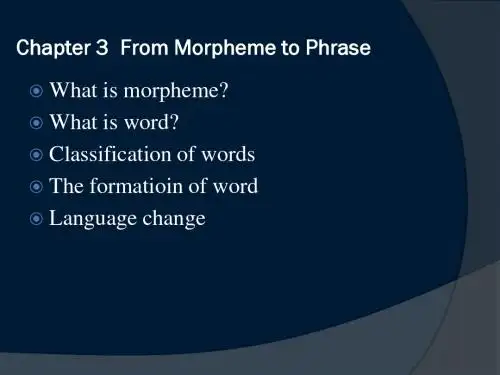
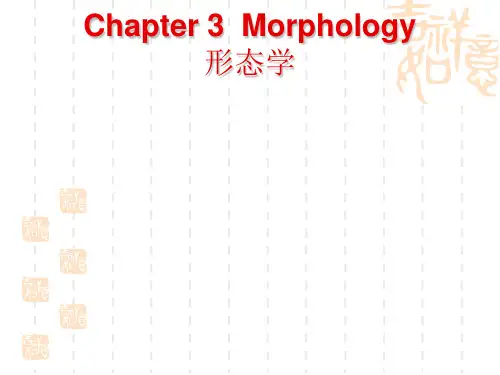
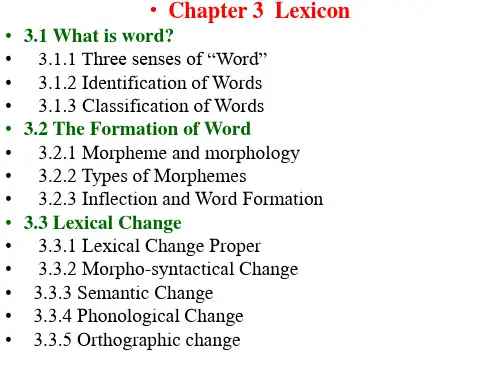
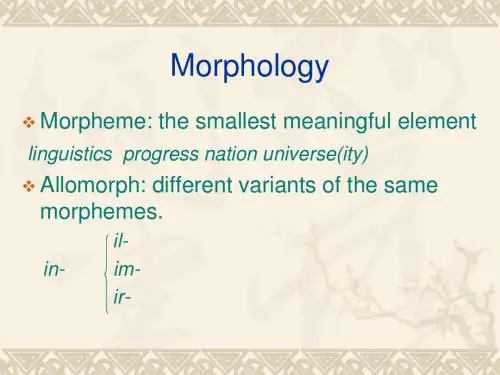
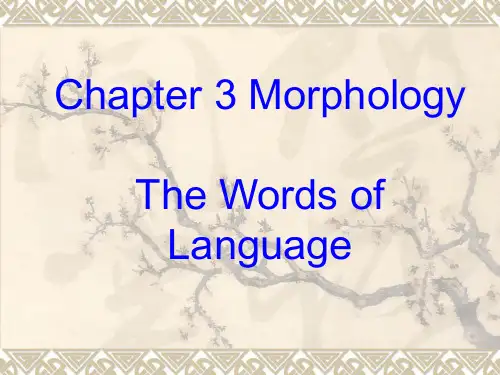
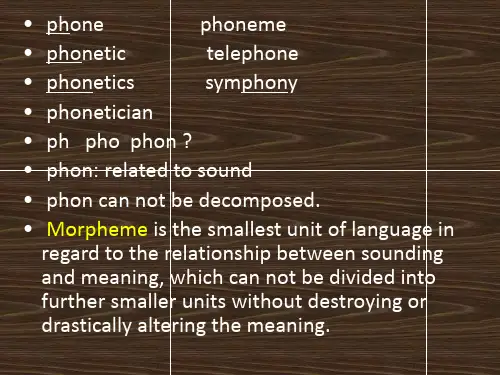
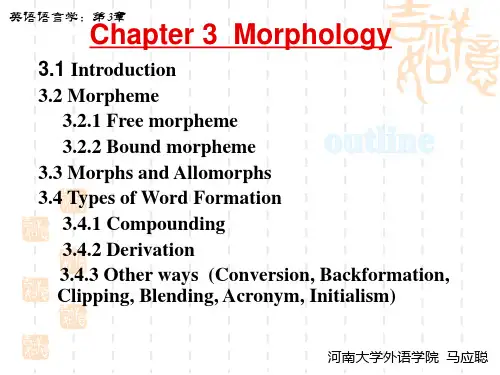
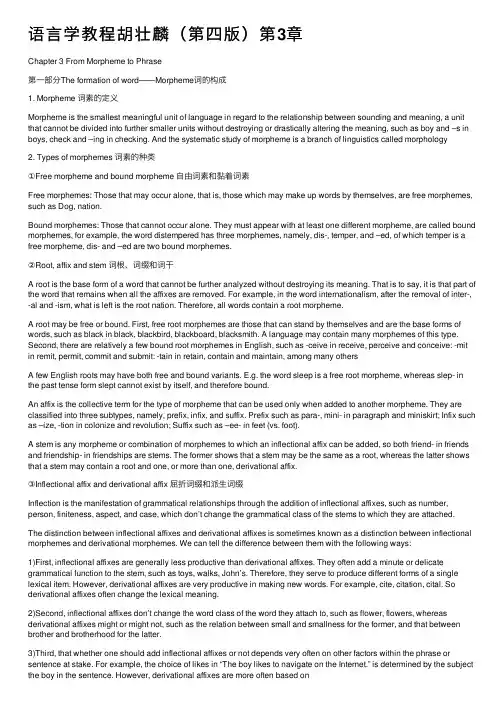
语⾔学教程胡壮麟(第四版)第3章Chapter 3 From Morpheme to Phrase第⼀部分The formation of word——Morpheme词的构成1. Morpheme 词素的定义Morpheme is the smallest meaningful unit of language in regard to the relationship between sounding and meaning, a unit that cannot be divided into further smaller units without destroying or drastically altering the meaning, such as boy and –s in boys, check and –ing in checking. And the systematic study of morpheme is a branch of linguistics called morphology2. Types of morphemes 词素的种类①Free morpheme and bound morpheme ⾃由词素和黏着词素Free morphemes: Those that may occur alone, that is, those which may make up words by themselves, are free morphemes, such as Dog, nation.Bound morphemes: Those that cannot occur alone. They must appear with at least one different morpheme, are called bound morphemes, for example, the word distempered has three morphemes, namely, dis-, temper, and –ed, of which temper is a free morpheme, dis- and –ed are two bound morphemes.②Root, affix and stem 词根、词缀和词⼲A root is the base form of a word that cannot be further analyzed without destroying its meaning. That is to say, it is that part of the word that remains when all the affixes are removed. For example, in the word internationalism, after the removal of inter-, -al and -ism, what is left is the root nation. Therefore, all words contain a root morpheme.A root may be free or bound. First, free root morphemes are those that can stand by themselves and are the base forms of words, such as black in black, blackbird, blackboard, blacksmith. A language may contain many morphemes of this type. Second, there are relatively a few bound root morphemes in English, such as -ceive in receive, perceive and conceive: -mit in remit, permit, commit and submit: -tain in retain, contain and maintain, among many othersA few English roots may have both free and bound variants. E.g. the word sleep is a free root morpheme, whereas slep- in the past tense form slept cannot exist by itself, and therefore bound.An affix is the collective term for the type of morpheme that can be used only when added to another morpheme. They are classified into three subtypes, namely, prefix, infix, and suffix. Prefix such as para-, mini- in paragraph and miniskirt; Infix such as –ize, -tion in colonize and revolution; Suffix such as –ee- in feet (vs. foot).A stem is any morpheme or combination of morphemes to which an inflectional affix can be added, so both friend- in friends and friendship- in friendships are stems. The former shows that a stem may be the same as a root, whereas the latter shows that a stem may contain a root and one, or more than one, derivational affix.③Inflectional affix and derivational affix 屈折词缀和派⽣词缀Inflection is the manifestation of grammatical relationships through the addition of inflectional affixes, such as number, person, finiteness, aspect, and case, which don’t change the grammatical class of the stems to which they are attached.The distinction between inflectional affixes and derivational affixes is sometimes known as a distinction between inflectional morphemes and derivational morphemes. We can tell the difference between them with the following ways:1)First, inflectional affixes are generally less productive than derivational affixes. They often add a minute or delicate grammatical function to the stem, such as toys, walks, John’s. Therefore, they serve to produce different forms of a single lexical item. However, derivational affixes are very productive in making new words. For example, cite, citation, cital. So derivational affixes often change the lexical meaning.2)Second, inflectional affixes don’t change the word class of the word they attach to, such as flower, flowers, whereas derivational affixes might or might not, such as the relation between small and smallness for the former, and that between brother and brotherhood for the latter.3)Third, that whether one should add inflectional affixes or not depends very often on other factors within the phrase or sentence at stake. For example, the choice of likes in “The boy likes to navigate on the Internet.” is determined by the subject the boy in the sentence. However, derivational affixes are more often based onsimple meaning distinctions. For example, the choice of clever and cleverness depends on whether we want to talk about the property “clever” or we want to talk about “the state of being clever”.4)Fourth, in English, most inflectional affixes are suffixes, which are always word final. E.g. drums, walks, Mary’s. But derivational affixes can be either prefixes, suffixes, or both at the same time. E.g. depart, teacher, international.3. Allomorph and morphological change 变体①allomorph 词素变体An allomorph is the alternate shapes of the same morpheme. Words such as illogical, imbalance, irregular and inactive share a common morpheme in-. In other words, il-, im-, and ir- are exceptionally the variation forms of one morpheme in-. These variation forms are called Allomorphs, i.e. allomorphs of the same morpheme owing to the influence of the sounds to which it attaches.②morphological change 形态变化Morphological change takes the form of inflectional changes in affixes.第⼆部分Word 词1. word 词和词项的定义Word is a typical grammatical unit between Morpheme and Word Group, such as boy, check, write, and fat. Lexical items refer to the cases when a word appears in different forms, such as boy and boys, or check, checks, checked, and checking. So Word is a general, covering term (boy and boys are one word) and Lexical Item a specific term (boy and boys are two lexical items).2. Three characteristics of word 词的三个特性①Stability 稳定性Words, concerning their internal structures, are the most stable of all linguistic units, Generally speaking, it is hard for one to re-arrange the internal structure of a complex word into a different order. For example, the word chairman cannot be re-arranged as * manchair, the latter being an unacceptable word in English.②Relative uninterruptibility 相对连续性Uninterruptibility means that new elements should not be inserted into a word, even when there are several parts in it. For example, nothing should be inserted in between the three parts of the word disappointment: dis + appoint + ment.③ A minimum free form 最⼩的⾃由形式Leonard Bloomfield advocated treating sentence as “the maximum free form” while word as “the minimum free form”. Word is the smallest unit that can be used, by itself, as a complete utterance. For example, Is Jane coming tomorrow? Possibly.3. Classification of words 词的种类①Variable and invariable words 可变词与不变词V ariable words have inflective changes. That is, the same word may have different grammatical forms but part of the word remains relatively constant. E.g. follow – follows – following – followed.Invariable words refer to those such as since, when, seldom, hello. They don’t have inflective endings.②Grammatical words and lexical words 语法词(功能词)和词汇词(实义词)Grammatical words(function words):Those that mainly work for constructing group, phrase, clause, clause complex, or even text are grammatical words, such as conjunctions, prepositions, articles and pronouns. Lexical words(content words):Those that mainly work for referring to substance, action and quality, such as nouns, verbs, adjectives and adverbs, are lexical words.③Closed-class words and open-class words 封闭类词和开放类词Closed-class word: A word that belongs to the Closed-class is one whose membership is fixed or limited, such as pronouns, prepositions, conjunctions, articles, and others.Open-class word: the Open-class is one whose membership is in principle infinite or unlimited. When new ideas, inventionsor discoveries emerge, new members are continually and constantly added to the lexical system of a language.④Word class(part of speech)词类This is close to the notion of parts of speech in traditional grammar.Nine word classes were established: they were noun, verb, adjective, adverb, conjunction, preposition, article, pronoun, and interjection.Today, a few more word classes have been introduced into grammer.i. Particles助词Particles include at least the infinitive marker “to” , the negative marker “not”, and the subordinate units in phrasal verbs, such as “get by”, “do up”, “look back”.ii. Auxiliaries助动词Auxiliaries used to be regarded as verbs. Because of their unique properties, which one could hardly expect of a verb, linguists today tend to define them as a separate word class.iii. Pro-form代词形式The items in a sentence which substitute for other items or constructions are called Pro-forms. For example, in the following conversation, so replaces that I can come.A: I hope you can come.B: I hope so.iv. Determiners限定词Determiners refer to those words that are used before the noun acting as head of a noun group, and that determine the kind of reference the nominal group has.第三部分Word formation 词汇构成1. Word formation(1):From Morpheme to Word 从词素到词(1) The inflectional way of formationInflection indicates grammatical relations by adding inflectional affixes, such as number, person, finiteness, aspect and case, which don’t change the grammatical class of the stems to which they are attached. For example, Table/tables.(2) The derivational way of formationDerivation, in its restricted sense, refers to the process of how new words are formed. It can be further divided into two sub-types: the derivational type (derivation) and the compositional type (compound).①Derivation派⽣Derivation shows a relationship between roots and affixes. In contrast to inflections, derivations can make the word class of the original word either changed or unchanged.E.g. Changed: delight+ful=delightful; unchanged: non+smoker= nonsmoker②Compound合成Compounds refer to those words that consist of more than one lexical morpheme, or the way to join two separate words to produce a single form, such as sunrise, cloakroom, railway. It can be divided into two types:(1) Invention 发明法Technological and economic activities are the most important and dynamic in modern human life, many new lexical items come directly from them, such as Coke, nylon.(2) Blending 混成法Blending is a relatively complex form of compounding, in which two words are blended by joining together the initial part of the first word and the final part of the second word, or by only joining the initial parts of the two words. For example, smoke+ fog →smog; breakfast + lunch →brunch.(3) Abbreviation / Clipping 缩写法/截断法A new word is created by cutting the initial part or the final part or cutting both the initial and the final parts of the original words. E. g. telephone→phone; fanatic→fan; influenza→flu.(4) Acronym ⾸字母缩略词Acronym is made up from the first letters of the name of an organization, which has a heavily modified headword. E. g. WTO→World Trade Organization(5) Back-formation 逆构词法Back-formation refers to an abnormal type of word-formation where a shorter word is derived by deleting an imagined affix from a longer form already in the language. E. g. editor→edit(6) Analogical creation 类推构词法The principle of analogical creation can account for the co-existence of two forms, regular and irregular, in the combination of some English verbs. E. g. work →wrought →worked.(7) Class shift 词性变换By shifting word class one can change the meaning of a word from a concrete entity or notion to a process or attribution. This process of word formation is also known as zero-derivation, or conversion. E. g. Engineer(v/n)(8) Borrowing 借⽤English in its development has managed to widen its vocabulary by borrowing words from other languages, such as Greek, French, Spanish and other languages have all played an active role in this process. There are four types of borrowing:①Loanwords(全部借词):a process in which both form and meaning are borrowed with only a slight change.E. g. coup d’ état , tea , 秀,脱⼝秀②Loanblend(混合借词):a process in which part of the form is native and the rest has been borrowed, but the meaning is fully borrowed. E. g. Chinatown 吉普车③Loanshift(转移借词):a process in which the meaning is borrowed, but the form is native. E. g. artificial satellite from the Russian S putnik.④Loan translation(翻译借词):a special type of borrowing, in which each morpheme or word is translated in the equivalent morpheme or word in another language, also called Calque. E. g. black humor (humour noir), found object (objet trouve).第四部分Word group and phrase 词组和短语Word group is a group of words, it is an expansion of a word.Phrase is a contraction of a clause nominal group, such as Verbal group, Adverbial group, preposition group.。
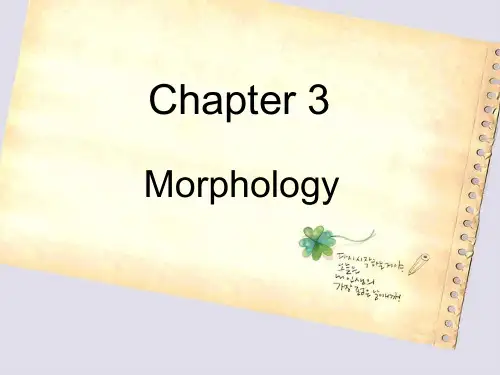
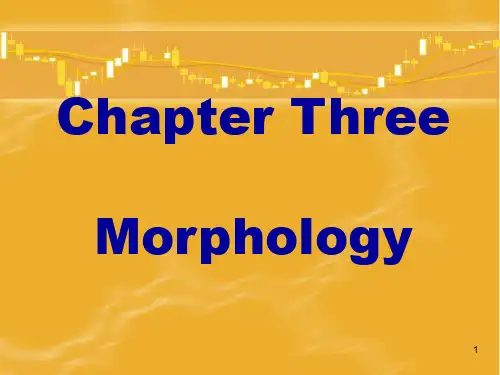
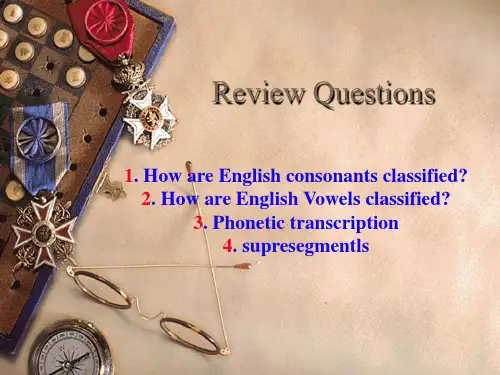
課程提綱課程名稱:語言學概論任課教師:孟智君課程性質:院考試課學分: 4教材:《新編簡明英語語言學教程》Chapter 3. MorphologyMorphology(形態學) refers to the study of the internal structure of words and the rules by which words are formed.1. Morphology◆Open class and Closed class⑴Open class words(開放詞類) — content words(實詞) of a language to which we can regularly add new words, such as nouns, adjectives, verbs, and adverbs, e.g.beatnik (a member of the Beat Generation), hacker, email, Internet; 做秀, 粉絲, 閃客in Chinese⑵Closed class words(封閉詞類)— grammatical or functional words(功能詞), such as conjunction, articles, preposition and pronouns.◆Morpheme: the minimal unit of meaningMorpheme(詞素) — a meaningful linguistic unit consisting of a word, such as man, or a word element, such a –ed in walked, that cannot be divided into smaller meaningful parts.★Words are composed of morphemes. Words may consist of one morpheme or more morphemes, e.g.1-morpheme boy, desire2-morpheme boy + ish, desir(e) + able3-morpheme boy + ish + ness, desir(e) + abl(e) + ity4-morpheme gentle + man + li + ness, un + desir(e) + abl(e) + ity5-morpheme un + gentle + man + li + ness6-morpheme anti + dis + establish + ment + ari + an + ism2. Affix◆Affix(詞綴) — a word element, such as a prefix or suffix, which can only occur attached to a base, stem, or root.◇Prefix(前綴) — morphemes that occur only before others, e.g. un-, dis-, anti-, ir-, etc.◇Suffix(後綴) — morphemes that occur only after others, e.g. –ful, -er, -ish, -ness, -able, -tive, -tion, etc.3. Free morpheme and Bound morphemeFree morpheme(自由詞素) is one that may constitute a word (free form) by itself, such as bed, tree, sing, dance, etc.Bound morpheme (粘著詞素) is one that may appear with at least one other morpheme. They cannot stand by themselves, such as –s in dogs, -al in notional, dis-in disclose, -ed in recorded, etc.4. AllomorphSome morphemes have a single form in all contexts, such as dog, bark, cat, etc. In other instances, there may be some variation, that is, a morpheme may have alternate shapes or phonetic forms. They are said to be the allomorphs(詞素變體) of the morpheme.◆For example, the plural morpheme may be represented by:map — maps [s] dog — dogs [z]watch — watches [I z] mouse — mice [a I]ox — oxen [n] tooth — teeth [i:]sheep — sheep [Φ]★Each of the underlined part is called an allomorph of plural morpheme. In morphemic transcription, morphemes in the abstract notion are put between braces like { }. The above can be expressed in the form of{ -s ~ -z ~ -iz ~ -ai ~ -i: ~ -n ~ -Φ }5. Derivational morpheme and Inflectional morphemeDerivational morpheme(派生詞素)— the morphemes which change the category, or grammatical class of wordse.g. modern — modern ize, length — length en, fool — fool ish, etc.Inflectional morphemes(屈折詞素) — the morphemes which are for the most part purely grammatical markers, signifying such concepts as tense (態), number (數), case (格) and so on; they never change their syntactic category, never add any lexical meaninge.g. ⑴number: table — table s, apple — apple s, car — car s⑵person, finiteness and aspect (體): talk — talk s — talk ing — talk ed⑶case: John — John’s◆Some other termRoot(詞根) — part of the word left when all the affixes (inflectional and derivational) are removed, e.g.desire in desirable, care in carefully, nation in internationalism, believe in unbelievable …Stem(詞幹) — part of a word-form which remains when all inflectional affixes have been removed, e.g.undesirable in undesirablesBase(詞基) — any form to which affixes of any kind can be added. This means any stem and root can be termed as a base.◆The difference between root, stem and base◇ A base can be added by both inflectional and derivational affixes while a stem can be added only by inflectional affixes.◇ A base is derivationally analyzable while a root cannot be further analyzed. In the word undesirable, undesire can be a base, but the root of this word should be desire.◇Root, stem and base can be the same form, such as desire in desired. Undesirable in undesirables is either a stem or base; desirable in undesirable is only a base.6. Morphological rulesThey are the rules that govern the formation of words, e.g. the “un- + —” rule.un + Adjective = not Adjectivee.g.un fair, un thinkable, un acceptable◆Productive Morphological Rules (能產性形態學規律) — the morphological rules that can used quite freely to form new words7. Compounds◆Compounding (stringing words together) is another way to form new words, e.g.land + lady = landladyrain + bow = rainbowunder + take = undertakeplay + ground = playground◆Noun compoundsX1X2Compound Patternwind + mill = windmill N + Nday + break = daybreakN + Vhair + cut = haircutcall + girl = call-girlV + Nplay + boy = playboy◆Verb compoundsX1X2Compound Patternbrain + wash = brainwashlip + read = lip-readN + Vbaby + sit = babysit◆Adjective compoundsX1X2Compound Patternman + eating = maneating N + V ingheart + felt = heartfelt N + V edduty + free = dutyfree N + Akind + heart(ed) = kindheartedA + N edabsent + mind(ed) = absentminded◆Preposition compoundsX1X2Compound Patternin + to = intoP + Pthrough + out = throughoutwhere + by = whereby Adv + P◆Some point about compounds⑴When the two words are in the same grammatical category, the compound will be in this category.e.g.N1: post, N2: box →N: postboxN1: land, N2: lady →N: landladyA1: icy, A2: cold →A: icy-coldA1: blue, A2: black →A: blue-black⑵When the two words fall into different categories, the class of the second or final word will be the grammatical category of compound.e.g.N1: head, A1: strong →A: headstrongV1: pick, N1: pocket →N: pickpocketException:N1: hair, V1: cut →N(1): haircut⑶Compounds have different stress patterns from the non-compounded word sequence.e.g.redcoat (Compound) ≠ red coat (Phrase)greenhouse (Compound) ≠ green house (Phrase)⑷The meaning of a compound is not always the sum of the meanings of its parts.。
Chapter 3 Morphology 形态学1.Definition 定义Morphology is a branch of grammar which studies the internal structure of words and the rules by which words are formed.形态学是语法学的一个分支,它研究的是单词的内在结构及单词的构成规则。
The aim of morphology is to find out these rules。
形态学的任务就是要找出这些规则(单词构成的规则)。
Morphology is divided into two sub-branches:inflectional morphology and lexical or derivational morphology. The former studies the inflections and the latter the study of word-formation.形态学可以划分两个分支:屈折形态学和词汇形态学(也叫派生形态学).前者研究的是单词的屈折变化,后者研究的是构词法。
2.Morpheme 词素2.1Morpheme: the smallest meaningful unit of language词素:语言中最小的意义单位Just as a phoneme is the basic unit in the study of phonology, so is a morpheme the basic unit in the study of morphology。
正如音位是音系学研究中的基本单位一样,词素是形态学研究中的基本单位。
Monomorphemic words 单词素单词2.2Types of morphemes 词素的类型2.2.1Free morphemes 自由词素The morphemes that are independent units of meaning and can be used freely all by themselves are called free morphemes。
戴炜栋语言学-Chapter 3 Morphology●开放类和封闭类Open class and closed class●开放性词类(open class words):名词、动词、副词和形容词●封闭性词类(closed words):连词、介词、冠词、代词●词素Morphemes---the minimal units of the meaning●词素的定义the definition●词素morpheme--带着信息和功能的语言的最小单位 a morpheme can be definedas.a minimal unit of meaning.例如:reader是由read和er两个词素组成 boys是由boy和-s两个词素●注意:●词素既不是意义,也不是音阶,而是意义和音阶的组合;●词素通常是任意的,他们的声音和意义之间没有必然的联系;●如果想区分词素之间的区别,可以使用语素(morph);●区分独立词和复杂词的区别:前者为单一词素构成,后者包括两个及以上的词素●词素的分类●自由和黏着词素(Free and bound morphemes)●自由词素:可以独立成词的词素成为自由词素 can be a word by itself●黏着词素:必须依附于另一个词素must be attracted to another one●同质异形体(Allomorphs)The variant forms of a morpheme are called its allomorphs.●Analyzing word structures分析词的结构●root词根 The roots constitutes the core of the word and carries the major component ofits meaning.●The roots typically belongs to a lexical category and are always bound morphemes.●affixes词缀 Affixes do not belong to a lexical category and are always bound morphemes ●Derivational and inflectional morphemes派生词素和曲折词素●派生词素:-en, -ate, and -ic are thus called derivational morphemes●曲折词素:there are bound morphemes which are for the most part of purelygrammatical markers and signify such concepts as tense, number, case and so on.●Morphological rules of word formation构词的形态学规则●词的构成方式被称为形态学规则(morphological rules),这些规则决定了词素怎样组合成为词。
Chapter 3 LexiconTime periods: two classesTeaching contents:3.1 definition of a word3.2 The formation of wordsTeaching aims and requirementsLearn by heart:1. The classifications of morphemes, such as free morpheme and bound morpheme, stem, root, inflectional affix and derivational affix.2. Two ways of word-formation such as inflections and derivations.Know:1. The definition of morphemes, free morphemes, bound morphemes, stem, root, affix, inflection and derivation and so on.2. Two different fields of morphology, including inflectional morphology and derivational morphology.Understand:1. Definition of a word2. The classifications of word according to different aspects3. The formation of wordsTeaching focus and difficulties:Focus:1. The definition of morphemes, free morphemes, bound morphemes, stem, root, affix, inflection and derivation and so on.2. The classifications of morphemes, such as free morpheme and bound morpheme, stem, root, inflectional affix and derivational affix.3. Two ways of word-formation such as inflections and derivations.Difficulty:1. Classification of morphemes2. Inflection and derivations.1. Review what we have learned in last chapter, and ask some students to answer the following questions: (5m)1) How are English consonants classified?2) How are English V owels classified?3) What are phonemes and allophones?2. Study3.1 Definition of a wordA word is a minimal free form of a language that has a given sound and meaning and syntactic function.Zhang Weiyou (1999)a minimum free formStability --internal structure (can’t rearrange)relative uninterruptibility --internal structure (can’t insert)Classification of words(1)Basic word stock & non-basic vocabularyContent words & functional wordsNative words & borrowed wordsVariable words & invariable wordsOpen-class words & closed-class wordsTraditional parts of speech & additional four categoriesClassification of words (2)Variable words & invariable words (variability)—variable words: the words whose form is changeable, words which might appear in different inflective and derivative forms, v. n.—invariable words: the words whose form is unchangeable, words which usually occur in the same form such as: since, in, for, of, at, onClassification of words (3)Open-class words & closed-class words (membership)--open-class words: membership is unlimited, n. v. (economic words, scientific words.)--closed-class words: membership is comparatively limited. Pronouns, conj, prep. Articles.Classification of words (4)Traditional parts of speech & additional four categoriesTraditional parts of speech:N. v. adj. Adv. Prep. Conj. Interj.ArticleAdditional four categoriesParticles : 小品词infinite maker ‘to’, negative maker ‘not’, subor dinate units in verbal phrases.Auxiliaries: 助词(助动词、情态动词)Pro-form 代词形式pro-v. pro-adj.e.g. He likes the animal, so do i.e.g. The desk is white, so is the chair.Determiners 限定词‘the’, ‘a’, ‘some’, ‘all’e.g. ‘all the beautiful Chinese girls’,3. Study 3.2 The formation of word1) Ask the students to skip over this section and find out the answers to the following questions:a. What is morphology?b. What is morpheme? What is the biggest difference between morpheme andphoneme?c. How can we classify morphemes?2) 3.2.1 MorphologyDefinition: the study of word-formation, or the internal structure of words, or the rules by which words are formed from smaller components: morphemes.For example:Verbs are formed by adding –ify to either an adjective (adj.) or a noun (n.)在形容詞或名詞加-ify變成動詞*simple (adj.) simplify (v) 簡化*quality (n) qualify (v)使具有資格*identity (n) identify (v) 認出MorphemesThe most basic element of meaning is traditionally called morpheme.The smallest meaningful components of words.E.g.: boyish孩子氣的;男孩似的boy, -ish (two morphemes)3) 3.2.2 Types of morphemes (1)Those that may constitute words by themselves,自由形式的詞素本身就是一個詞,可以單獨使用e.g.: boy, girl, table, nation.Free morphemes PK Bound morphemesThose that cannot occur alone,Bound morpheme includes two types: roots and affixes.e.g.: -s in dogs, -ed in worked, dis- in dislike, un- in unable.A certain affix here refers to an inflectional affix: grammatical endingsTypes of morphemes (2)Root: the part left when all the affixes are removed 词根Stem: the part left when a certain affix is removed 词干Affix: the part which is attached to other words; usually bound morphemes 词缀E.g.: friend as in unfriendliness.Roots may be:Free: those that can stand by themselves,E.g.: black+board; nation+-al; orbound: those that cannot stand by themselves,E.g.: -ceive in receive, perceive, conceive.Affix: normally divided into:Prefix (dis-, un-) prefixes occur at the beginning of a word.suffix (-en, -ify) at the endinfix (foot-feet) in the middlePrefix 前綴mis- 誤mistake 誤解over- 過分overdo 做得過分Prefixed modify the meaning of the stem, but usually do not change the part of speech of the original word.Exceptions are the prefixes be-, and en(m)-.Added to adjectives or nouns they turn the words into verbs.Suffixes modify the meaning of the original word and in many cases change its part of speech.Accordingly, there are noun-forming suffixes, adjective-forming suffixes, adverb-forming suffixes, and verb-forming suffixes.-er teacher, writer-ician “...(專)家,...工作者”electrician電工-bility “能力”possibility可能性-hood “時期”childhood幼年時期,童年時期-age “(人生的)某一時期”orphanage孤兒-ary (adj) elementary基本的, secondary第二位的-ful (adj) beautiful美麗的, delightful愉悅的, sorrowful悲傷的-en (V 使..) weaken使變弱, darken, deepen-ize (v …化) modernize使現代化-ly (adj+ -ly=adv n + -ly= adj) slowly慢慢地, friendly友善的-ward (往…方向) forward(adv)往前, eastward往東Stem: a morpheme or combination of morphemes to which an inflectional affix may be added,e.g.: friend+-s; write+-ing, possibility+-es.A stem can be a bound root, a free morpheme, or a derived form itself.e.g.:*toler- (root) + affix –ate: tolerate忍受*quick (free morpheme) + affix –ly: quickly *careless (a derived form) + affix lessInflectional affix: Bound morphemes which are for the most part purely grammatical markers, signifying such concepts as tense, number, case etc.e.g.: -ed, -s, -erHe had regular features. 他五官端正。